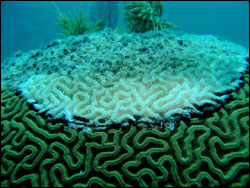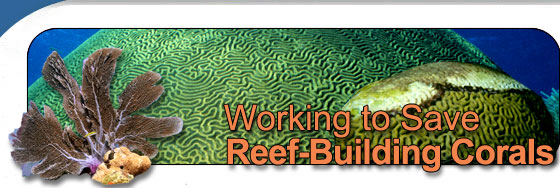Error processing SSI file
|
Mission Log Aug. 13, 2008
Kathleen Morrow
Auburn University
The scientists and Nancy Foster crew spent the better part of the previous evening watching the Olympic games in the mess hall, making for an early morning at 0700. The entire scientific team convened on the last site in Sherwood Forest (SF03) this morning in order to complete the entire radial belt transect in one dive. SF03 is a beautiful reef set in about 50 - 70 feet on a pinnacle of coral and old coral rubble.
 |
| A Foureye Butterflyfish feeding along the margin of black-band disease affecting Boulder Star Coral (Montastraea sp.). (Photo: Kathy Morrow) |
Scientific teams were rearranged so that the ‘girls’, with the most efficient air consumption, c, w, with would dive first and establish the site - which includes locating the stake, orienting the line, and beginning the radial belt from due North. Co-Principal Investigator, Laurie MacLaughlin, and I examined each coral within our sampling area. With our heads buried in every crack and crevice of the reef, we rely on our line tender (Sarah Fangman) to keep us set on the correct course. The line tender also doubles as the look-out for any ‘visitors’ to our sampling site, as was the case at Looe Key. There, Lonny Anderson was line-tending when a 7-8 foot grey reef shark materialized out of the hazy abyss and buzzed past our shoulders. The grey was just curious and circled the group several times before departing, but it got my heart racing. Though we knew it wasn’t displaying any aggressive behaviors, scientists can get scared too…
 |
| Black band disease can affect many different species of coral, like this Symmetrical Brain Coral (Diploria strigosa). (Photo: Kathy Morrow) |
Back in Sherwood Forest, Laurie and I were looking for men in tights, but were joined by men in wetsuits instead! Perhaps that is for the best. The second scientific team began their radial arc in the opposite direction and met us halfway around. There was quite a bit of healthy coral and sea fans. At this site, there was little disease overall but there was evidence of cyanobacteria and macroalgal growth on the majority of the corals. We are unsure of the role cyanobacteria and macroalgae play in whether a coral is affected by disease, but these observations provide another reason why long-term data-sets are invaluable when trying to determine the multiple triggers for coral health and disease. Both teams surfaced at approximately the same time and headed back to the Foster for an afternoon of fun in the sun at Fort Jeff.
After 5+ days of diving, the scientific team and ship crew were happy to steam into the Dry Tortugas National Park and drop anchor just north of Garden Key and Fort Jefferson. We were shuttled to the island and toured the fort interior and exterior. Some of us attempted to circumnavigate the fort’s mote wall while snorkeling, looking out for giant tarpon and eagle rays. Of course everyone was discussing the curious abundance of reef organisms living along the mote wall, then realized we just can’t stop being nerds… but that’s why we love our jobs! We are a small group this year and with our similar interests and love for the work, we have again grown quite close to one another. After all, there is nothing better than to be surrounded by good people, coral reefs and miles of open ocean – in my opinion.
|



